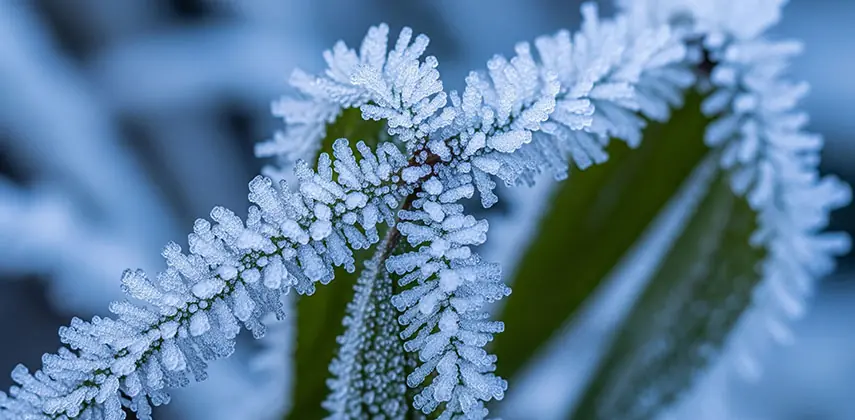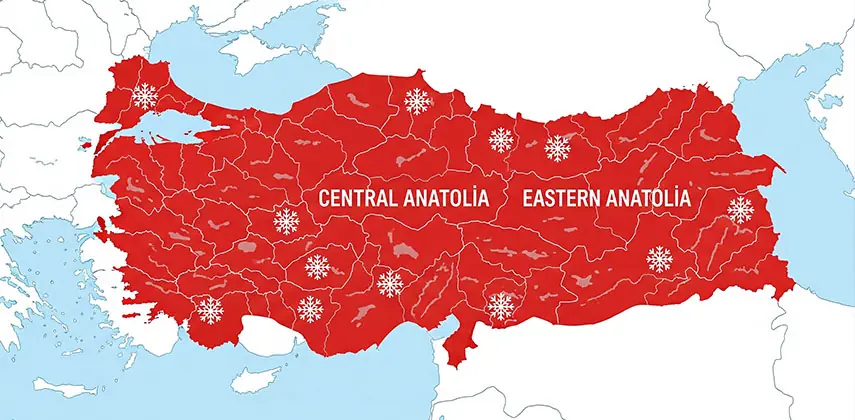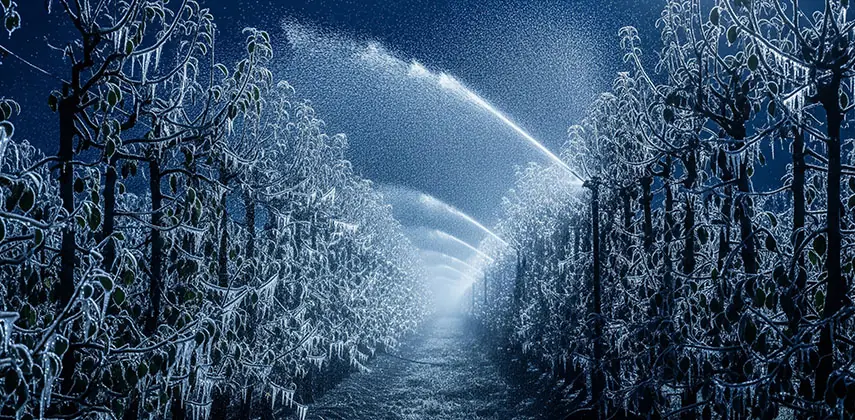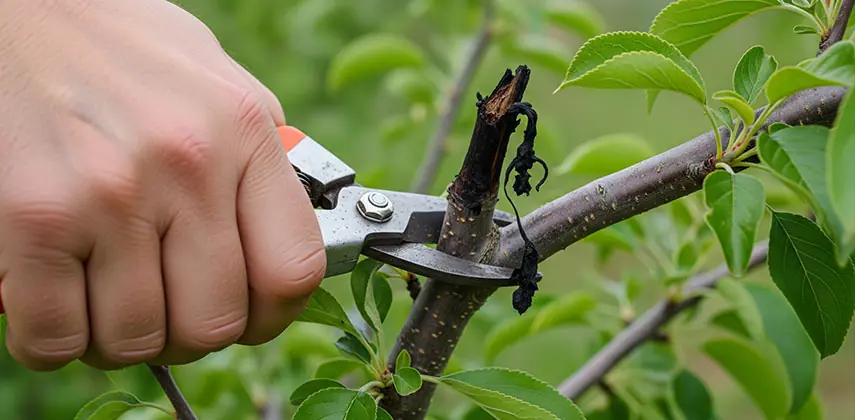Agricultural frost, or crop freeze, is one of the most devastating natural disasters that can destroy a farmer’s year-long efforts in a short time and lead to severe economic losses. Since this issue directly affects farmers’ livelihoods and financial stability, access to accurate, reliable, and practical information is of great importance.
This comprehensive guide will help you better understand agricultural frost, learn scientific and practical prevention and intervention methods to combat it, and take the necessary steps to minimize losses and protect your crops.
Section 1: What is Agricultural Frost?
To effectively combat any phenomenon, it is essential to first understand it correctly. Agricultural frost occurs when the air temperature drops below 0°C (Celsius). This temperature drop causes the water inside plant cells and tissues to freeze, leading to severe damage or even the complete death of the plant

When Is the Risk of Frost Higher? This phenomenon usually occurs during calm and clear nights in the spring and autumn seasons. Spring frosts cause the greatest damage to orchards because they coincide with the flowering and young fruit formation period.
Which Crops Are More at Risk? Different plants have varying sensitivity to frost:
- Fruit Trees: Early-blooming species such as peach, apricot, almond, cherry, and plum are highly vulnerable to spring frosts. Citrus fruits and grapes are also among other sensitive crops.
- Vegetables: Crops like tomatoes, peppers, potatoes, eggplants, cucumbers, and zucchinis are very sensitive and suffer damage quickly when temperatures drop below freezing. Leafy vegetables such as cabbage, spinach, and lettuce are relatively more resistant.
- Cereals and Field Crops: Warm-climate plants like corn, cotton, and sunflower are susceptible to frost. Wheat and barley are more resilient, but severe and untimely frosts can halt their growth.
Browning, blackening, and a water-soaked appearance on leaves, stems, and buds.
Burning and dropping of flowers and newly formed fruits.
Cracks in the bark of tree trunks.
Significant reduction in yield, loss of quality, and market value of the crop.
Types of Frost According to Severity (Classification by the General Directorate of Meteorology)
- Light Frost: Temperatures between 0°C and -2.2°C. Causes damage to sensitive vegetables and fruit trees in the flowering stage.
- Moderate Frost: Temperatures between -2.2°C and -4.4°C. Causes serious damage to buds, flowers, and young leaves.
- Severe Frost: Temperatures below -4.4°C. At this temperature, even tree trunks and roots can be damaged, and the damage is widespread.
Section 2: Frost-Prone Regions and Seasons in Turkey
Knowing the high-risk areas helps farmers take necessary precautions in advance.

- Central Anatolia and Eastern Anatolia: These regions have the highest risk of frost. In Central Anatolia (Konya, Karaman), temperatures can drop to -10°C, while in Eastern Anatolia (Erzurum, Kars), they can fall as low as -30°C.
- Inner Parts of Aegean, Mediterranean, and Marmara Regions: Unlike the coastal areas with mild climates, the inner and high-altitude parts of these regions (such as Afyon, Isparta, Bolu) face significant frost risk.
- Southeastern Anatolia: Despite generally mild winters, regions like Gaziantep and Şanlıurfa have a risk of sudden frost events
Section 3: Basic Methods of Frost Protection
Control methods are divided into two main categories: passive (preventive and administrative measures) and active (emergency interventions during frost events). The best results are achieved through a smart combination of these two approaches
A) Passive Methods – Taking Smart Precautions
These methods include long-term measures applied before the frost risk occurs.
1. Selecting Appropriate Planting Areas:
- Avoid planting sensitive crops in areas known as “frost pockets,” where cold air tends to settle.
- Areas near large bodies of water (lakes, rivers) carry less risk as they help moderate temperatures.
- South-facing slopes in the Northern Hemisphere are warmer and more suitable for crops like grapes and early potatoes.
- Creating windbreaks with tree rows or artificial barriers can prevent cold air from entering the fields.

2. Selection of Resistant Species and Varieties:
- Using late-blooming varieties (such as late-flowering apples) or frost-resistant species (such as winter wheat) significantly reduces the risk of damage.
3. Proper Field and Orchard Management:
- Weed Control: Clean, weed-free soil absorbs more heat during the day and releases it throughout the night.
- Avoiding Soil Disturbance: Compacted and moist soil retains heat better than loose, tilled soil. Avoid unnecessary tillage during frost-prone seasons.
- Proper Plant Nutrition: Healthy and strong plants are more resistant to environmental stresses, including frost.
B) Active Methods – Intervention During Danger
- One of the most effective methods. When water freezes on the plant, it releases latent heat of fusion (about 80 calories per gram of water). This released heat keeps the plant surface temperature around 0°C, preventing damage.
- Important Note: Irrigation should begin before the temperature reaches freezing and must continue uninterrupted until the ice on the plants naturally melts (usually after sunrise). Stopping irrigation during the process can increase damage.

2. Fogging/Smudging:
- Creating an artificial layer of fog or smoke over the field acts like a blanket, preventing heat from escaping from the ground. Thermal fogging machines, such as frost protectors, can create an artificial cloud curtain that raises the ambient temperature by several degrees.
3. Air Mixing:
- During a temperature inversion, a warmer air layer exists a few meters above the ground. Wind machines or even helicopters mix this warm air with the colder air near the surface, increasing the temperature around the plants.
4. SPECIAL SOLUTION: Agricultural Frost Candles, the Savior of Orchards on Frosty Nights

SPECIAL: Agricultural Frost Candles – The Savior of Orchards on Frosty Nights
One of the most efficient, economical, and proven active methods is the use of agricultural frost candles (Frost Candles). Designed to burn slowly and long (8 to 12 hours), these candles create a reliable heat shield for your crops.
Their smart operation works in two ways:
Heat Generation: These candles can noticeably raise the air temperature in the orchard by 3 to 7 degrees Celsius.
Protective Smoke Creation: The dense smoke produced acts like a blanket, preventing heat stored in the soil from escaping.
Offered by reputable brands using biofuels and 100% natural materials, this method is not only easy to use but also safe (spark-free) and reusable. Numerous successful cases—from completely saving vineyards in Europe to protecting banana greenhouses in Turkey—confirm the definite effectiveness of this solution
- Bahçe sobaları veya bahçenin çeşitli yerlerinde çok sayıda küçük ateş yakmak, sıcaklığı doğrudan artırmak için geleneksel bir çözümdür. Bu yöntem, yalnızca yıldaki donlu gece sayısı az ise ekonomik olarak mantıklıdır.
- Amino asitler, deniz yosunu özleri, potasyum ve kalsiyum gibi maddeler içeren bu solüsyonlar, don tahmininden 1-2 gün önce bitkilerin üzerine püskürtülür. Hücre duvarını güçlendirerek ve bitki özsuyunun yoğunluğunu artırarak donma noktasını düşürür ve bitkinin dona karşı direncini artırırlar.
Section 4: Actions to Take After a Frost Event
If your crop suffers frost damage despite all efforts, the following steps will help the plant recover and be saved:

- Carefully Assess the Damage: Check the extent of damage to branches, buds, and flowers before taking any action.
- Prune the Damaged Parts: Prune completely blackened and dried branches and buds to direct the plant’s energy toward saving healthy parts.
- Disinfection and Treatment: Disinfect pruned areas with copper-based compounds to prevent the entry of fungal and bacterial diseases.
- Reinforcing Irrigation and Fertilization: The plant is under intense stress. Regular watering and the use of supplementary fertilizers containing nitrogen, phosphorus, potassium, and micronutrients (zinc, boron, calcium) greatly aid in the plant’s recovery.
Section 5: The Role of Technology and Early Warning Systems
In modern agriculture, forecasting is the key to success

- Follow Weather Forecasts: Regularly monitor reports from the General Directorate of Meteorology.
- Use Smart Weather Stations: Systems like T-Weather monitor your field temperature in real-time with sensitive sensors and send you instant SMS alerts when the temperature approaches a critical point. These technologies give you the opportunity to timely implement active frost protection methods.
Conclusion
Agricultural frost is a serious threat, but it is not uncontrollable. A knowledgeable and prepared farmer can successfully overcome this challenge by utilizing long-term planning (passive methods), timely intervention (active methods), and new technologies (warning systems). By selecting appropriate methods based on your region’s conditions, crop type, and frost severity, you can protect your investment and labor, ensuring the sustainable productivity of your field or orchard.

